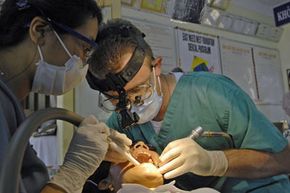There are people out there who do not fear dental work. They're called dentists, and all 142,000 of the ones practicing in the United States took the DAT [source: BLS].
Dentistry, like most high-paying professions, is a competitive field. Dental schools get thousands of applications every year, and that number is steadily increasing. Between 2001 and 2006, the number of applications to U.S. dental schools nearly doubled to reach 11,000 [source: DSB]. That rise in interest brings a rise in admissions standards, and one of the primary considerations in acceptance is the Dental Admission Exam, or DAT.
Advertisement
Nothing is guaranteed, but rocking the DAT is a good way to start pursuing a dental career. The test is a big one -- more than three hours long, 280 questions, typically just three chances to score high and required by every accredited dental school in the country. It tests several different skill areas, including math, science, reading comprehension and perceptual (or spatial) ability, and every area matters, contributing to eight different scores that dental schools look at when determining who to accept. The overall purpose is to predict who will excel both in dental school and, later, as a dentist -- essentially, who has what it takes to go the distance.
The DAT is not the only part of an application that matters. College performance, for example, is a significant component, too. But the test is the largest single contributor to an acceptance or a rejection. In this article, we'll take a look at the Dental Admission Exam and find out what it's all about. We'll see what the content is like, how the scores are generated, how to study for it and what's required to register for the test.
We'll begin with the basics: What's on it?
Advertisement



